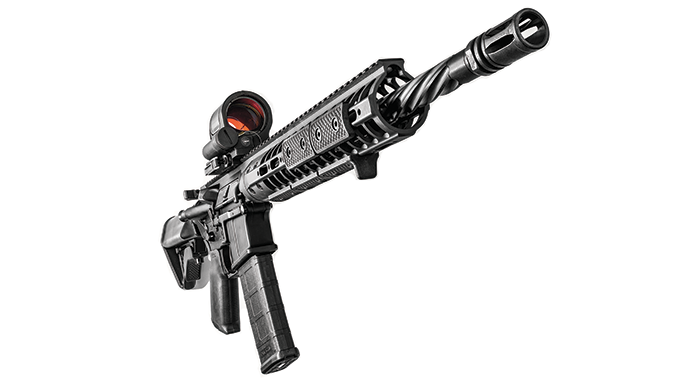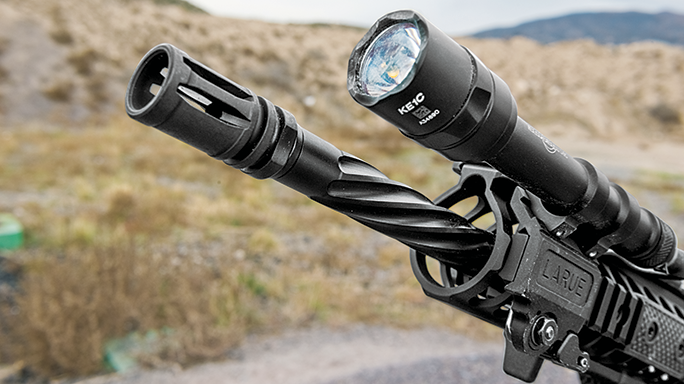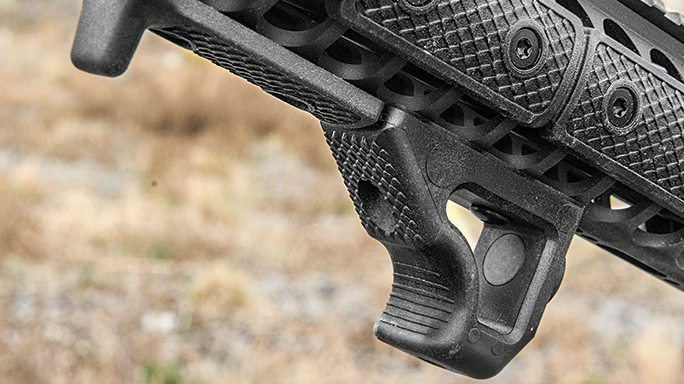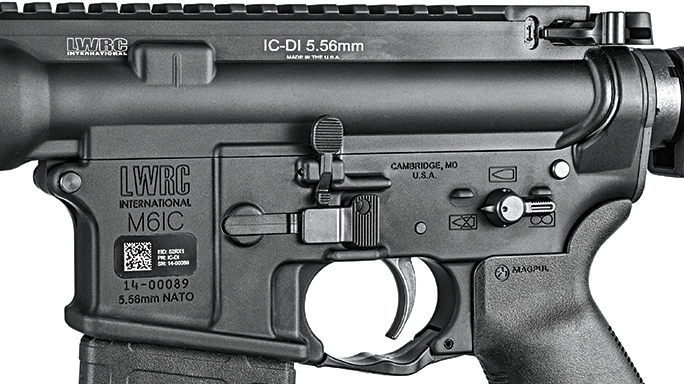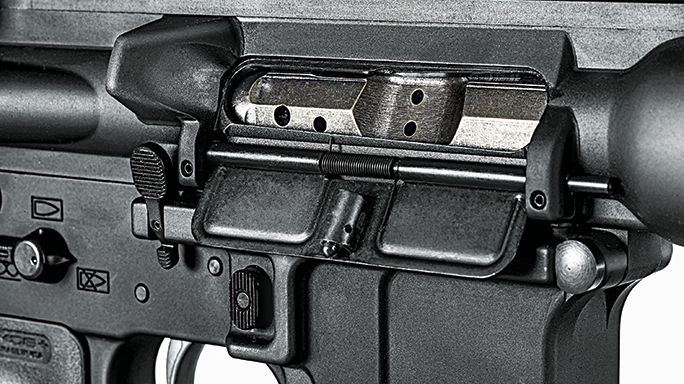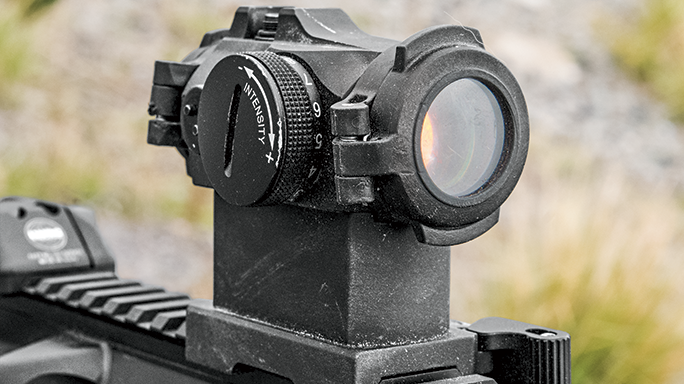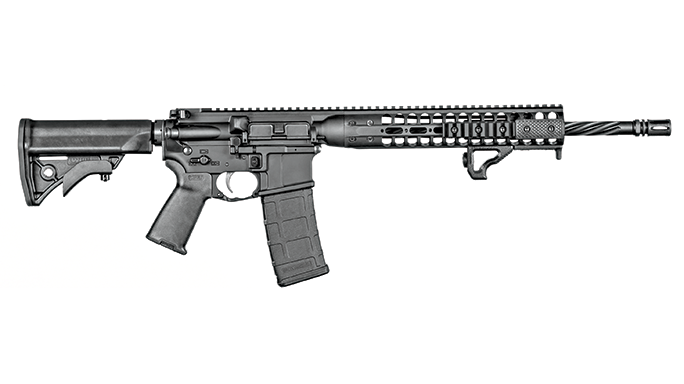After testing several LWRC International rifles, they have become some of my favorites. I’m a fan of the 6.8 SPC, and I’ve spent many hours and thousands of rounds behind the company’s piston-driven Six8 rifles using various barrel lengths. Recent testing of LWRCI’s 5.56mm IC-PSD variant of the Individual Carbine (IC) platform was an eye-opening experience. I took it to a couple training courses and tested it for hours on my home range, and it ran everything I put through it, including some frangible ammunition that choked every other rifle I’ve used it in.
- RELATED STORY: Warrior’s Trident: LWRCI’s TRICON MK6 Rifle
Professionals, law enforcement officers and discerning buyers have long sought out LWRCI when looking for a workingman’s rifle. Built to high standards and designed for hard use, they are among the most dependable and reliable carbines on the market. Their only drawback is cost—like any quality product, especially a piston-driven carbine, they are not cheap. Piston-driven rifles have more parts and tend to weigh more. For those with no need for a piston system, direct-impingement (DI) ARs are a great option. What we needed was a DI rifle from LWRCI, and the company has come through with the 5.56mm IC-DI.
A Closer Look
Advertisement — Continue Reading Below
The IC-DI starts with LWRCI’s proven “double coined” upper and lower receivers, which are forged from 7075-T6 aluminum. They’re easily some of the strongest receivers you can buy. Like all IC rifles, the lower receiver sports ambidextrous controls and an oversized triggerguard. A Magpul MOE+ grip is installed for enhanced control, while the LWRCI Compact stock makes it easy to use the IC-DI while wearing plate carriers or other duty gear. The lower’s internals, including the trigger, are mil-spec.
The upper receiver features a 16.1-inch, cold-hammer-forged barrel with a 1-in-7-inch twist rate, M4 feed ramps and a 5.56mm NATO chamber. The barrel is also fluted for reduced weight and improved cooling. Out front is an A2-style flash suppressor. The barrel is made from 41V45 steel and coated in NiCorr for longevity and corrosion resistance. Gas is delivered to the enhanced DI bolt carrier group using a NiCorr-coated gas tube.
Surrounding the barrel and gas system is a slim, 12-inch handguard developed specifically for the IC-DI rifle. Attaching solidly at the receiver, it allows the barrel to float freely. Rails can be attached along the 3, 6 and 9 o’clock positions. The continuous top rail facilitates sights and other accessories. Rail panels were provided with my test rifle along with the company’s Angled Foregrip. It also came with two accessory rails: a short one for lights or lasers and an angled rail that includes a quick-detach (QD) sling cup. There is also a QD sling cup on the back of the Angled Foregrip. Each rifle ships with a single Magpul PMAG.
Advertisement — Continue Reading Below
Top Training
Headed to the San Antonio Texas area for some extra long-range training put me in the neighborhood for a Lights, Sights & Lasers Tour stop. Taught by my friend and colleague Wes Doss, it focuses on police encounters in low and failing light conditions. It includes half a day of classroom training and about four hours on the range with a carbine.
I decided to add a few things to the IC-DI based on my experience. I added a Trijicon MRO in a brand-new AXTS mount. This sight has proven excellent with a less obstructed view. The controls are easy to access, and it is rugged yet lightweight. The precision- machined AXTS is very sleek, easy to use and strong. This mount placed the LWRCI backup sights I added in the lower third of the MRO’s lens. Another addition was LaRue Tactical’s MBT-2S trigger. I prefer two-stage triggers, and LaRue’s is one of the best. It’s smooth with a wider and slightly flatter shoe. It’s also easy to install with a captured sear while offering a 2.5-pound first stage and a crisp 2-pound second stage. My final change was a Primary Weapons Systems Triad flash suppressor. It has proven to all but eliminate flash on any 16-inch-barreled carbine.
Advertisement — Continue Reading Below
I also added a SureFire Scout light in a LaRue Tactical light mount. Finally, I added a Vickers sling from Blue Force Gear. I used several 5.56mm loads from various manufacturers for ammunition.
Wes Doss focuses on fast target acquisitions from unconventional starting positions. Rather than start amped up in a standard position, you start with the rifle hanging from its sling. Then you engage targets under stress at close range (from 5 to 20 yards) using only your backup sights—sighting through or over your reflex sight if you have one. There was also a shootout among students where the winner walked away with over $1,000 in prizes. The MRO really shined here because of its wide field of view. This was my fifth time through this training with various rifles and reflex sights, and the MRO was the fastest I’ve used to date.
The IC-DI’s ambidextrous controls came in handy. I recently injured my strong hand, so I had to alter how I normally operate the safety. The IC lower uses a pinned safety with standard-sized levers on both sides. This allowed me to run the rifle with my strong-hand thumb forward throughout the drills, which isn’t my preference for CQB situations. But this was less painful while still being fast. The LaRue trigger once again shined. Smooth and crisp, it allowed for control when needed and speed when necessary. It has not failed when used in four different rifles, including the IC-DI. All in all, the carbine ran well and never missed a beat.
Advertisement — Continue Reading Below
Range Testing
Back at my home range, I measured the IC-DI’s accuracy after reinstalling its factory trigger. I was able to produce groups under an inch, with the best measuring just over 0.6 inches using Barnes’ 70-grain TSX ammo. The IC-DI was plenty accurate. Moving to a nice two-stage trigger will likely improve things, but for a duty-ready rifle, this is more than adequate.
Donning a Velocity Systems plate carrier, the short stock proved invaluable. My arms are short to begin with, and standard stocks just extend my arms too far. LWRCI’s short stock makes it possible to keep the rifle squarely in my workspace for reloads and other quick manipulations.
Advertisement — Continue Reading Below
The ambidextrous controls were a boon, and it was good practice to primarily use my left side. Having the bolt release on both sides allowed me to use a couple different reloading methods. The carbine ran smoothly, even inside my range’s shoothouse. Because of my strong-side injury, I mostly used the IC-DI from my left side during the entry practice, with the SureFire light’s tape switch mounted on top of the handguard for easy access. Having the light on the left side also meant that it cleared obstacles first when working around corners.
Moving around my FJ Cruiser took a bit of work considering I’m used to resting my left side on the bumper, for example. Once again, the ambidextrous controls really helped. It was possible to operate the safety easily. The safety levers are the same size on both sides of the receiver, making the transition much easier. Those shorter safety levers are great for precision rifles, but not when you need to reach them with your off-side thumb. It took some practice, but after a couple of runs I got the hang of running the IC-DI from my left side, making me quite confident that I could use this rifle effectively in any practical condition.
Accurate & Reliable
Advertisement — Continue Reading Below
The IC-DI never suffered a single malfunction. The ejection patterns were incredibly consistent over several types of ammunition. Even in less conventional shooting positions, brass never hit me in the face. Also, LWRCI’s Angled Foregrip is the best I’ve used so far. It provides excellent control while serving as a stable support against barricades and other objects.
- RELATED STORY: IC-A5: LWRCI’s Award-Winning, Suppressor-Ready Rifle
LWRCI is offering the IC-DI for $1,600, which is comparable to other top-tier ARs. And, this model is as good as any top-tier AR I have tested. Short of a custom rifle, it just does not get much better than this. Everyone has their preferences when it comes to features, but everything on this rifle is top notch. More importantly, it is built like a tank with a robust gas block, cold-hammer-forged barrel, forged receivers and an enhanced bolt carrier group.
For more, visit lwrci.com or call 410-901-1348.
Advertisement — Continue Reading Below
Specifications
- Caliber: 5.56mm NATO
- Barrel: 16.1 inches
- OA Length: 32-35.25 inches
- Weight: 6.7 pounds (empty)
- Stock: Collapsible
- Sights: None
- Action: Direct impingement semi-auto
- Finish: Matte black
- Capacity: 30+1
- MSRP: $1,600
